Powering the Slum: Meeting SDG7 in Accra’s Informal Settlements

More than a billion people worldwide live in informal settlements and lack proper access to energy. This case study explores energy poverty in the slums of Accra, Ghana, where illegal electrical hookups are the norm. How can we reverse this trend while providing safe, reliable, and affordable energy to all?
At a Glance
Key Challenge
Residents of informal settlements in the Global South need affordable and reliable electricity, but they often access it illegally.
Policy Insight
The first step is for governments to officially recognize these settlements. Energy companies can then relax regulations for energy connections, supply postpaid meters, and offer alternative energy sources.
Introduction
Now in its sixth year, the United Nations’ Transforming Our World agenda with its 17 Sustainable Development Goals (SDGs), encourages countries and cities to monitor their progress with special attention to local priorities. The 193 UN member states had crafted this agenda as a follow-up to years of economic and social development programs that began with the Decade of Development (1961) and ended with the Millennium Development Goals (2000 – 2015).
In this version, the nations characterized the work as “a plan of action for people, planet, and prosperity,” aiming to eradicate poverty everywhere in the world within its 15-year timeline. The SDGs represent a consensus aspiration for all countries. They cover topics ranging from health to infrastructure to energy and urban life, with improvements that assist in meeting the aim while supporting sustainability and economic development.
In this regard, many rapidly urbanizing, low-income nations in the Global South are focusing on SDG 7, “Ensure access to affordable, reliable, sustainable and modern energy for all.” It is an especially important goal for low- and moderate-income nations that are not only confronting increasing energy demand and inefficiencies due to population growth but also trying to balance post-COVID recovery and climate change.
To measure the success of the SDGs, the UN developed indicators that nations can use for reporting their progress on all the SDGs to the General Assembly’s High-Level Political Forum, convened annually. For SDG 7, two indicators (7.1.1, the proportion of population with access to electricity, and 7.1.2, primary reliance on clean fuels and technology) are important because they address two UN concerns, dealing with poverty and improving the environment. In an effort to understand the challenges involved in meeting SDG 7, this policy brief will review the baseline conditions in the informal settlements of Accra Metropolitan Assembly (AMA), Ghana.
Situation Analysis
Home to a billion people worldwide and increasing, the population in informal settlements, often called slums, is contributing a significant share of urban growth. In Sub-Saharan Africa today, slum dwellers account for 238 million people, nearly a quarter of the global total and 54% of the African urban population (UN 2019; World Bank 2018).
Residents of informal settlements in cities of the Global South are especially needful of affordable and reliable electricity for lighting and cooking, as well as powering household and personal appliances like refrigerators and mobile phone chargers. While these residents lack basic services in general, the absence of reliable electricity serves as a significant barrier to their ability to escape poverty and live safe, healthy, productive lives.
Without reliable power, for example, students struggle to study after dark, workers struggle to perform their jobs (especially informal occupations characteristic of these areas), and everyone faces personal safety threats—with streets and public spaces that are not illuminated at night. The lack of affordable energy leads to reliance on charcoal, wood, or dung for cooking that contributes to chronic lung disease. In contrast, reliable electricity has positive effects on the lives of informal settlement dwellers including improving their health, education, quality of life, and well-being (Waddams 2000; Desai et al.2010; Parikh et al. 2012). See Box 1.
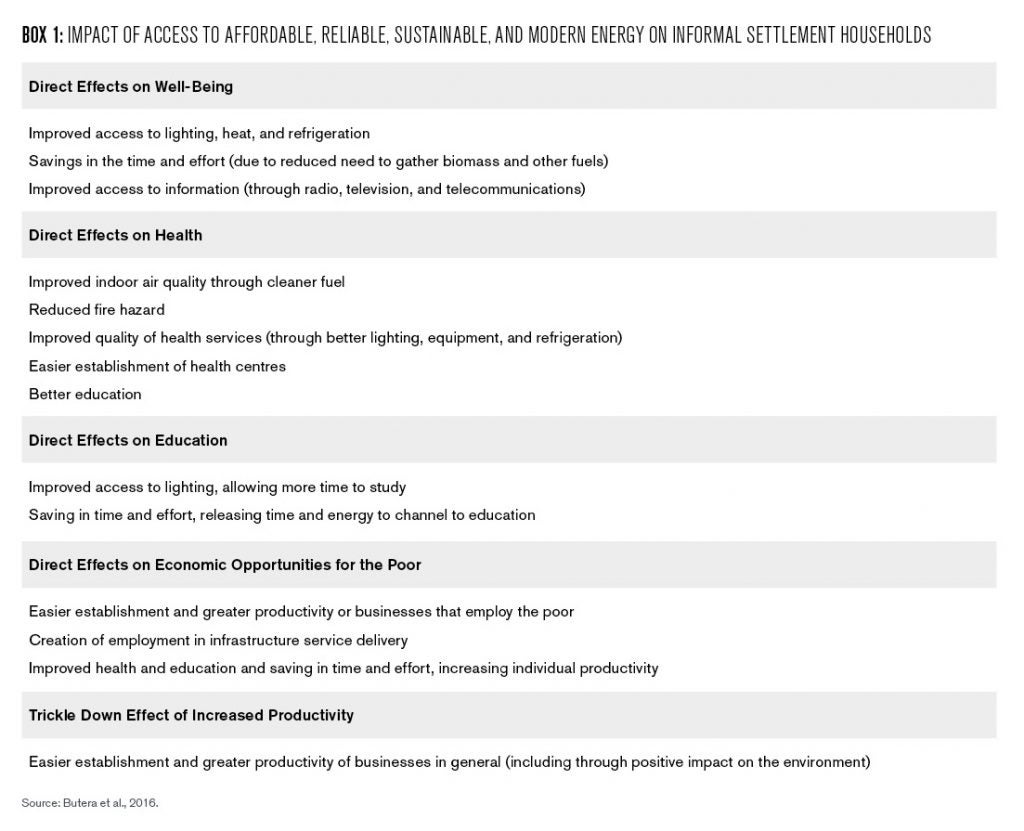
Despite extensive discussions on the importance of sustainable and reliable energy for informal settlement dwellers, existing evidence on its delivery is limited (Ghosh and Kanjilal, 2014; Singh et al., 2015; Westphal et al., 2017; Parikh et al., 2012; Jones, 2017; Mulugetta et al., 2019; Nathwani and Kammen, 2019).
Clearly, SDG 7 cannot be achieved without a combination of national and local energy policies (Westphal et al., 2017). The World Bank emphasizes the importance of this observation in Electricity Access in Sub-Saharan Africa, Uptake, Reliability, and Complementary Factors for Economic Impact (2019, xv):
Access to reliable electricity is the backbone of any modern economy…If African nations want to see their economies transform, the issue of electricity must be tackled head-on. Access is only the starting point…the problem in Africa is not power but poverty… reliability, affordability, and coordination are the links missing between making utilities viable and expanding their consumer base. Reliability and affordability go hand-in-glove: blackouts and brownouts are common in Africa. Reliable electricity would persuade consumers that electricity is a service worth paying for, and more consumers would bring down the cost of producing electricity.
Current State of Energy Affairs
Across the globe, three-quarters of a billion people do not have access to electricity. Some 75% (580 million) live in Sub-Saharan Africa (IEA 2020). Most of the deprived live in rural areas, but as will be described in this policy brief, city dwellers, especially those in informal settlements experience problems. See Figure 1
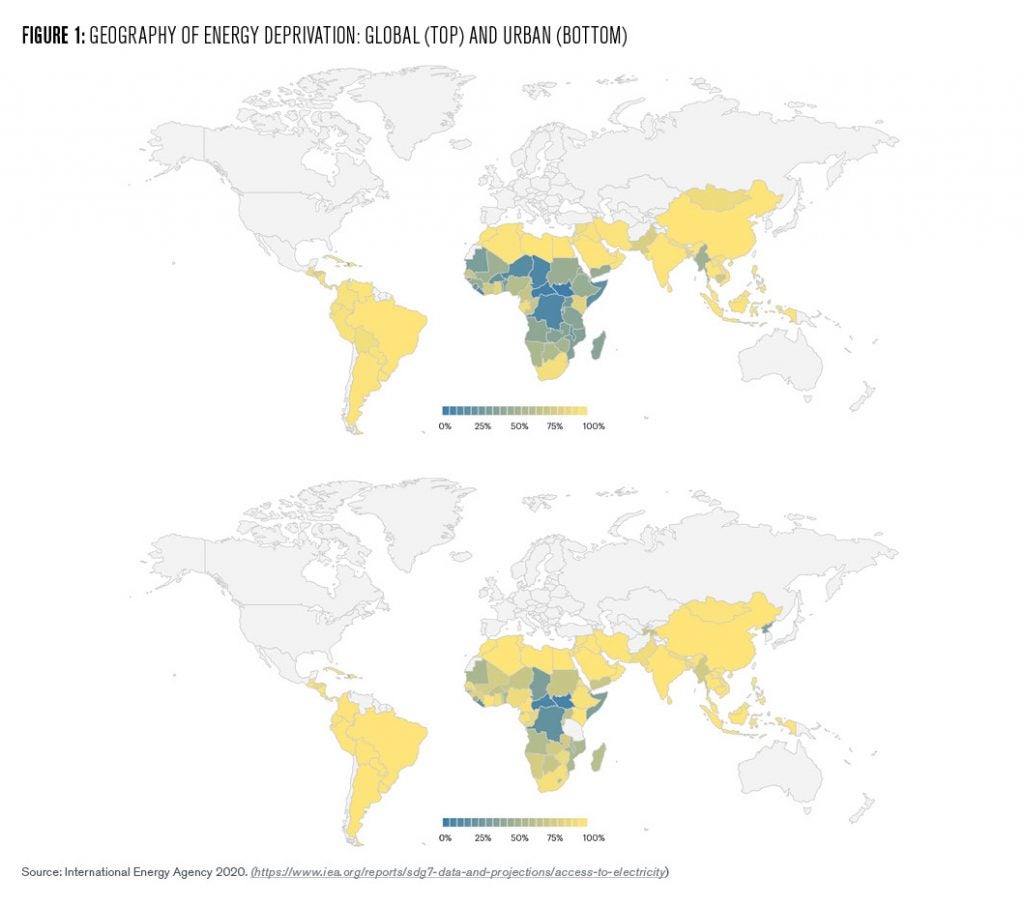
Of note, the International Energy Agency (IEA) monitors energy access but its data understate the situation in informal settlements, because accurate enumeration simply does not exist. The IEA is reliant on national and local authorities or utilities for the information. Governments either rarely count (or severely undercount) the population in informal settlements, because they fear legitimizing them (Lemaire 2015; Desai et al., 2010; GNESD, 2007; Modi et al., 2006).
In addition, utility companies, stretched to capacity while dealing with rapid urbanization, favor new affluent middle-income neighborhoods over informal settlements for ease of installation and the promise of paying customers (Butera 2016). Therefore, UN data that report high rates of energy access in urban areas in Sub-Saharan Africa do not include a large number of households that live in informal settlements, since the local governments for which the UN relies do not count informal settlements regularly.
Electricity in Ghana
Ghana, a country with 31 million inhabitants, is rich in electricity generation infrastructure based on hydro (42%) and thermal (58% using natural gas) sources. In the past decade, Ghana has doubled the capacity, yet this supply is fragile. Droughts and natural gas shortages affect production (Mathematica 2019, 22). Two state-owned utilities, the Electric Company of Ghana (ECG) and the Northern Electricity Distribution Company (NEDCO) distribute electricity in the south and north respectively. ECG services 80% of the power market, including the Greater Accra Region with its five million inhabitants (Mathematica 2019, 23; Ghana Statistical Service 2020). See Figure 2.
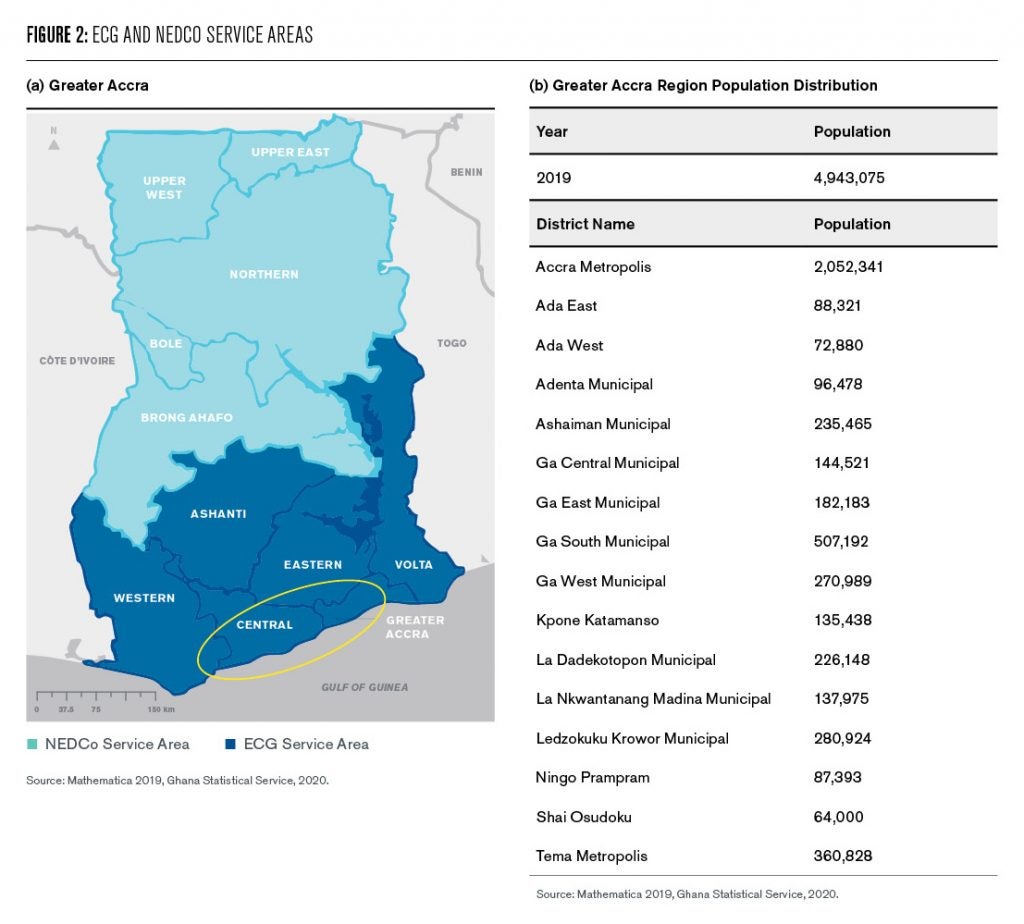
According to Ghana’s Voluntary National Review issued to the UN’s High-Level Political Forum in 2019, 81% of its population is connected to the national grid but the distribution is uneven—the south has higher rates. The household connection rate ranges, from the lowest in the rural Upper East Region (48%) to the highest in the urbanized Greater Accra Region (95%) (Republic of Ghana 2019, 61). Data from other sources state that 90% of the country’s urban population and 67% of its rural population have access to electricity (CIA 2020; Ghana Statistical Service 2019). See Figure 3.
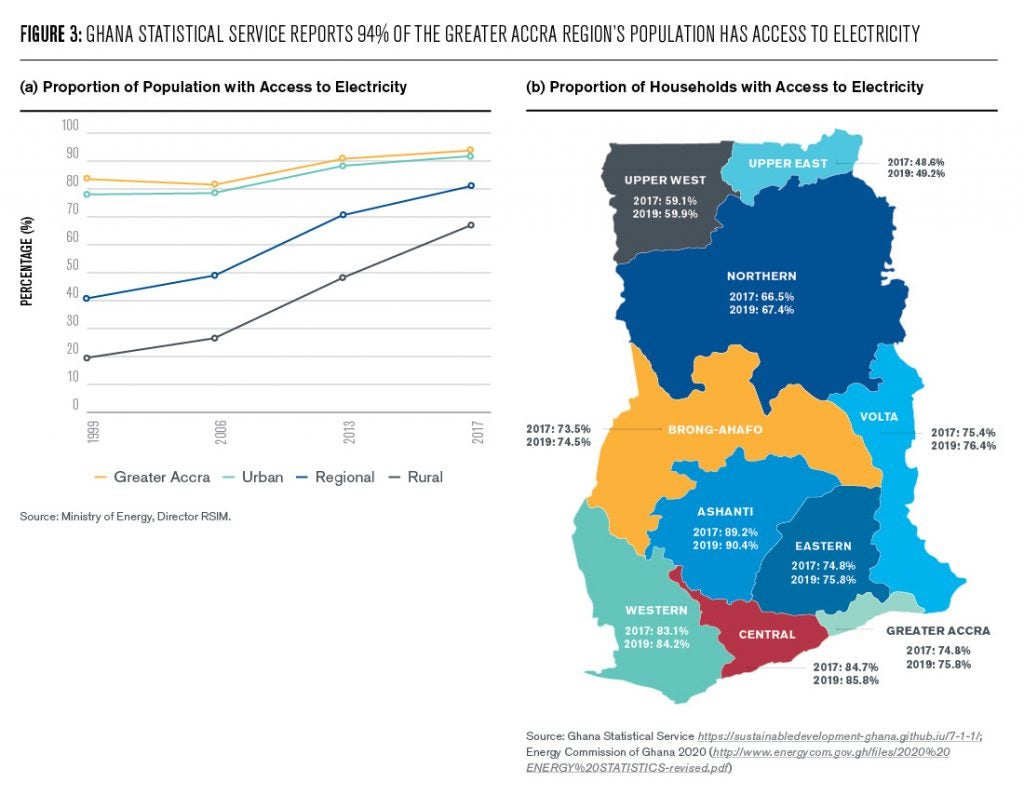
Further, according to a survey of the 265 informal settlements of the AMA, which was undertaken in 2016 by The People’s Dialogue, a nongovernmental organization affiliated with Slum/Shack Dwellers International (SDI), 88% of households had access to electricity. While the report does not detail the nature of the connections (i.e. legal or illegal), it does include an illustration and a comment on the high incidence of fire due to illegal connections. See Figure 4.

On the surface, the data on energy access are impressive. However, a deeper probe of the situation for informal settlements stimulates questions about the nature of the access. In 2007, the most recent date for which this information is available, 54% of all households in the AMA acquired their electricity connection illegally (Ghana Statistical Service 2007). Research for this policy brief reveals that the situation has worsened in the ensuing years. For example, in the study areas, 75% of the residents have illegal connections.
Explanations for these illegal connections are clear:
- Poor Service. ECG has “a long history of poor operational performance and has not adequately invested in “grid maintenance, operations, staff capacity, and customer service”—making it vulnerable to theft as surveillance is weak (Mathematica 2019, 1,21).
- Tough Requirements. ECG denies electricity to households that cannot meet requirements for wiring, building codes, and property ownership, again leading to ad hoc and illegal arrangements (Mathematica 2019, 21).
- High Tariffs. Even if a household qualifies for a meter, ECG tariffs are very high, offering a further disincentive to connect legally. While in the past five years ECG has widely instituted prepaid meters (as opposed to credit-pay-by-month meters), it has increased its tariff schedule by 59%. (Most informal settlement households with legal meters have a pre-paid plan.)
- Steep Pricing. While ECG has a low “lifeline” fee for minimal service, beyond that point the price per unit rises. And most households need more than the minimal quota.
- Additional Fees. In addition, the fee includes other charges beyond the cost of a unit of power (e.g. 5% levy for street lighting; 5% for national electrification programs) (Mensah 2016).
In fact, high levels of energy theft contribute 32% to ECG’s substantial revenue gap—the remaining deficit is attributed to technical (losses in distribution and transmission) and commercial (low collections due to theft) issues (MIDA 2015). For example, in the first six months of 2018, ECG’s deficit was estimated at $200 million (Akalaare 2018). In addition to the implications for ECG’s business model, the illegal connections have social costs. Illegal connections are massively unsafe, resulting in high incidences of electrocution and fire outbreaks (Yakubu, Badu, et al., 2018).
While these phenomena have delayed Ghana’s achievement of its National Electrification Scheme goal of providing 100% electrification for all by 2020, the national government is attempting to address these problems through the Ghana Power Project, a multi-year, multi-pronged remedial program instituted in 2016 and currently in force (IEA 2012; MIDA 2020). The Millennium Development Authority (MIDA) a special vehicle created by Parliament, administers the project that is funded by more than a half a billion dollars in grants from the U.S. Millennium Challenge Corporation (Mathematica 2019).
The project’s several programs deal with efficiency, reliability, and access issues. The majority of the funding is dedicated to improving transmission and other system problems to address the technical losses described above. However, it targeted a small amount of the total budget, $10 million, to support small- and medium-sized enterprises that comprise 40% of the nation’s economy. This fund has a special focus on small businesses located in markets (Ernst & Young 2019, 11). Here, it is providing legal connections and lighting. It is, in fact, a response to a terrible fire that consumed a major market in Accra in which thousands of traders lost their livelihoods. Included in these upgrades are the eight places in the Greater Accra Region; with two in AMA: the Makola and Agbogbloshie Markets.
In a second example, the project is supporting a $26 million demand management effort to develop standards for energy-efficient appliances. And as a first step, the government prohibited the purchase of second-hand European refrigerators that reportedly used 50% of total residential energy consumption prior to the law. However, the project has no focus on improving services to households in informal settlements.
A Deeper Look
The AMA’s estimated population of 446,000 lives within its 23 square mile area. Four out of ten residents live in informal settlements of varying maturity and size. These settlements are places where residents lack legal tenure or structures do not comply with local building and housing codes (People’s Dialogue 2016; UN Habitat, 2011). The AMA is experiencing rapid urbanization with growth occurring through natural increase and rural-to-urban migration, both putting pressure on existing informal settlements and leading to new ones, all of which need electricity. Another factor fueling the increase in the AMA’s demand for electricity is an increase of the middle class, who often remain in informal settlements in spite of their upward mobility because they have either improved their housing over time, cannot afford housing in formal settlements, or have deep personal and employment networks that they want to retain.
To provide detailed information about the nature of energy access in informal settlements, this policy brief examines three informal settlements in the AMA: Agbogloshie (Ashiedu Keteke Subdistrict), Chorkor (Ablekuma South Sub-Metropolitan District,), and Avenor (Okaikoi South Sub-Metropolitan District). See Figure 5.
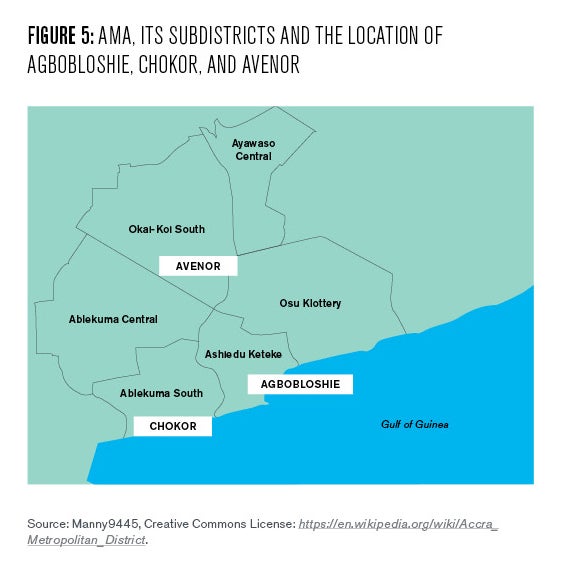
Agbogbloshie
Agbogbloshie occupies 360 acres of wetlands along the Korle Lagoon and is the city’s major drainage basin. It is situated about a kilometer from AMA’s central business district. Settled by migrants arriving from the north in the 1980s, most of its 80,000 residents do not hold legal title to their land (Oteng-Ababio 2018; Afenah 2012). Presently, the settlement is a hub for a wide range of informal economic activities, most notably a highly polluting and dangerous e-waste recycling industry that processes electronic devices. Its residents also find jobs in the food markets, petty trade, vehicle repair, electronics refurbishment and repair, and transport services (Grant and Oteng-Ababio 2016; Grant and Oteng-Ababio 2019). See Figure 6.
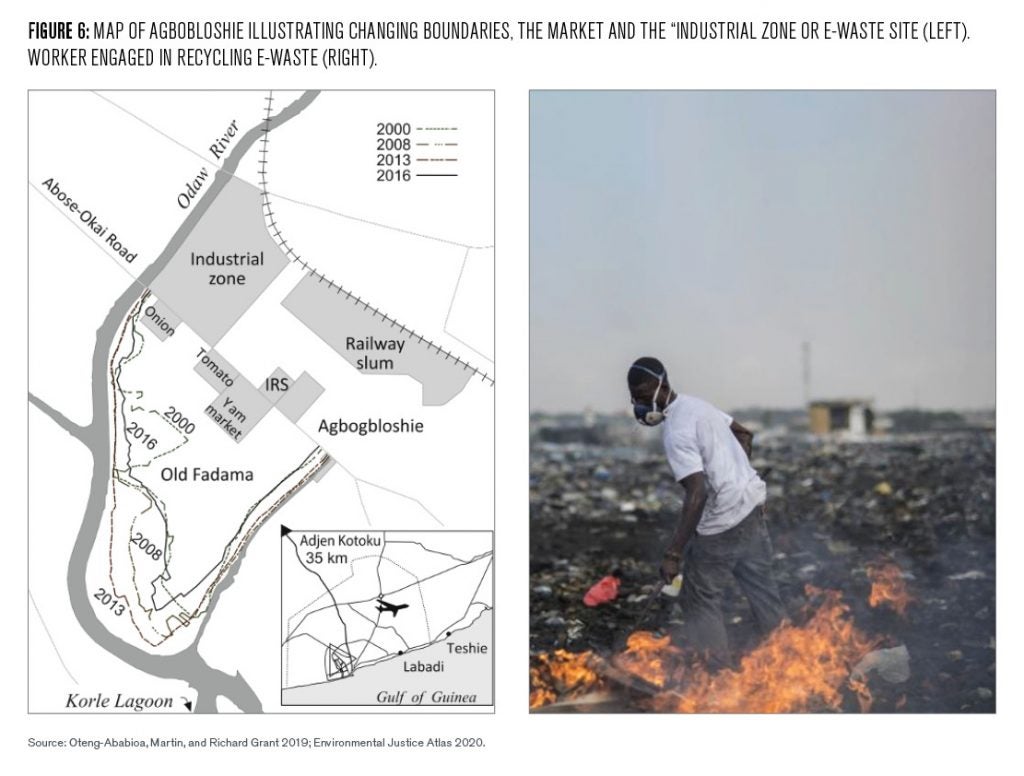
Chorkor
Chorkor, one of the oldest indigenous communities along the coast of the AMA, is located on the site of an 1820s fishing village. Its 25,000 residents occupy 300 acres. Their jobs in the informal economy center on fishing as well as trading and service activities including the sale of food stuffs, hair dressing, and sewing.
Avenor
Avenor, an inland settlement dating from the 1970s, has a population of 11,840. The majority of residents own their land according to customary (tribal) law. They have jobs in petty trading, tailoring, shoe repair, hair dressing, food vending, sale of sachet water, vulcanizing, construction, and car repair.
The residents of these three areas are poor. The majority live in dilapidated, overcrowded housing with little tenure security in neighborhoods that lack basic infrastructure (e.g. water, sewer) and services (e.g. education, health, fire protection). They are constantly at risk of eviction, disease, and violence (The People’s Dialogue, 2016). See Figure 7.
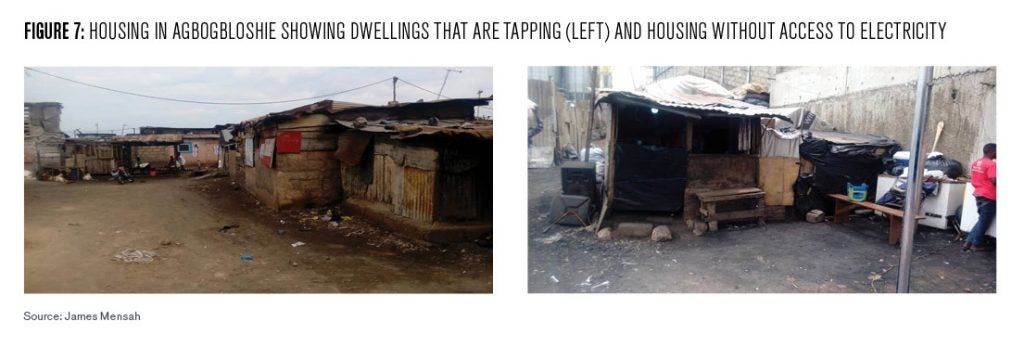
Understanding the energy story for these places requires going beyond the official statistics. What follows is a product of the synthesis of secondary and primary data, results from focus group discussions in the three informal settlements, interviews with government and energy officials, household surveys and field observations conducted in the fall of 2019. Dr. James Kwame Mensah, Chief Resilience Advisor in the Accra Metropolitan Assembly and a lecturer at the University of Ghana supervised this work.
The Real Energy Story
Residents in Informal settlement employ a wide range of energy-consuming products in their daily living. They use electricity for lighting, ironing, freezing food, and powering television. Due to the high cost of electricity, they use charcoal and firewood for cooking and commercial activities, a practice that has well-known negative health effects. To deal with the city’s power outages (so frequent that they have a local name, “dumsor,” the Twi word for “on/off”) residents use generators, car batteries, and torchlights (Aidoo and Briggs 2020).
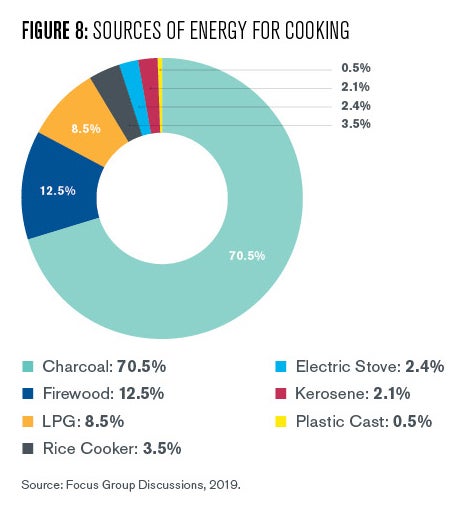
The findings in the three informal settlements revealed that the electricity theft is even worse today than was reported more than a decade ago. Unable to provide required documentation or reluctant to pay the high tariffs associated with legal connection, some 75% of informal settlers in the study areas access electricity illegally. Either they purchase a meter from a middleman, often an ECG employee or a specialized “meter contractor,” at a highly inflated price, or they tap into a neighbor’s meter for a negotiated fee. Sometimes, for a price, ECG workers connect a line directly into the dwelling without installing a meter.
The cost of acquiring a meter legally from ECG is GHC 400 (US$ 68). The price of securing an illegal one is much more expensive—up to 500% more than the legal rate (US$ 344). This high price is due to premiums the buyer pays to the middleman. The price often includes the cost of cables and a new utility pole (absent in unplanned informal settlements), which then must be installed by a private contractor.
Other illegal electricity connections (see Figure 9) take various forms of “tapping” into the system:
- U-Connection. The “U-connection” bypasses the meter completely. U-connections don’t generate bills, because energy use is behind the meter.
- Pin-Connection. The “pin connection” uses a nail to tap electricity from a wire that passes at the back of the wall. See Figure 9.
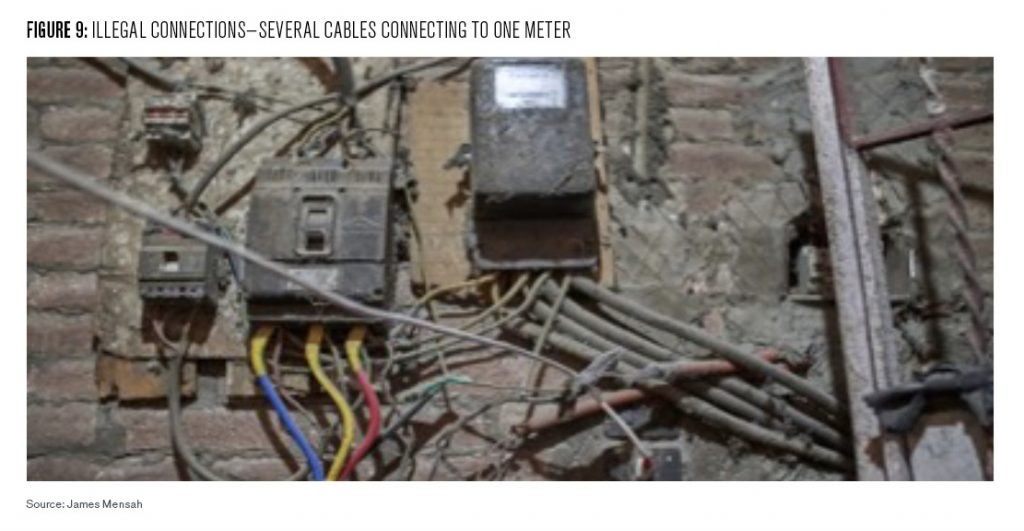
In the “tapping” system, a major challenge is determining the level and timing (monthly/weekly) of fees. No standard exists. In practice, some meter-holders set a flat fee while others allot the payment according to the number of electric gadgets (light bulbs, refrigerator, TV, electric iron) in the tapping household.
Our focus groups estimated that beyond installation fees, informal settlement dwellers pay 60% more than others for their power—whether using an illegal meter or tapping,
Any attempt to eliminate theft is complicated, likely meeting stiff resistance from many sides. The illegal activities support a variety of actors. For example, income from “tapping” helps the meter-owner survive, as does the extra money (bribes) given the low-paid ECG worker or middlemen providing the illegal meters.
Residents who would not be able to secure electricity due to the rigorous ECG requirements are also beneficiaries of the system. (Of note, and beyond the scope of this brief, electricity theft is widespread in formal settlements as well.) However, the outcome is clear: illegal connection practices have led to a vicious cycle of poor service, high tariffs, and lack of investment (maintenance and improvements) from the financially strapped ECG.
Energy Policies in Ghana
The role of the state in developing an appropriate institutional and policy framework is crucial for achieving Goal 7. Ghana does have one. And multiple agencies are charged with carrying it out. See Figure 10.

The country has a Strategic National Energy Plan (2006 – 2020); National Energy Policy (2010 – 2015), Energy for Poverty Reduction Action Plan (2005) SE4ALL Action Agenda (2012, 2016), Renewable Energy Master Plan (2019), and others aimed at providing a sound energy market and securing a reliable energy supply for the nation.
However, some have argued that the lack of attention to informal settlements by national energy authorities has perpetuated the activities: illegal meters and tapping (King et al., 2012). For sure, the issue is larger than energy—at its root is the land tenure question. That is, how to deal with the fact that the residents, as illegal squatters, have no property rights.
At the local level, the AMA does not have any specific policy or regulations related to the provision of electricity in informal settlements. AMA’s only role is the issuing of building permits suitable to meet ECG meter acquisition requirements.
Recommendations
The fact that informal settlements are widespread in the AMA and elsewhere in Ghana, calls for dedicated state policy to address energy needs in these areas. Clearly, any such recommendations require negotiating the landscape of Ghana’s complex energy policy framework and its administration. Nonetheless, here are four ideas to consider. They range from broad efforts regarding property rights to narrower concerns in the application of ECG practices.
Recognize Informal Settlements
Offer legal recognition to informal settlements, providing the right to basic services including electricity and its associated infrastructure. Some cities have begun to deal with this problem, with solutions that are beyond the scope of this paper. In general, this policy requires undertaking a variety of approaches to secure tenure and undertake slum upgrading programs based on planning and coordination among national and local authorities.
Tied to this approach might be the adaptation of Michael Porter’s essay on local economic development, first articulated in an article focused on western slums, “Competitive Advantage of the Inner City,” whose principles have relevance for the informal settlements of AMA and indeed, the Global South. The argument is to identify and support niche industries that can move from supplying neighborhoods to supplying wider markets. Such businesses have locational and human resource advantages (Porter 1995).
Relax Requirements for Accessing Electricity
Relaxing the rigorous prerequisites for securing meters deserves more study. Appropriate authorities can reform the system, keeping such requirements as building codes, that are necessary for the safe delivery of electricity but eliminating others that have little relevance to energy access. While land ownership may serve as a proxy for household creditworthiness and ability to pay the bills, other methods such as long-term participation in self-help groups, can be used in parallel with intensified consumer education programs on energy efficiency, the necessity of tariff payments, and so forth.
Provide Postpaid Electricity Meters
The ECG’s pre-paid electricity meters are burdensome to the consumers in informal settlements. These households often do not have the ability to pay upfront for their energy; they find the prepayment system cumbersome and time-consuming and fear the loss of continuous power or having an inconsistent supply of power. These factors encourage illegal connections. Offering postpaid electricity meters may be one way to reduce theft. In this case, arrangements for payment would have to be standardized and include termination of the service as a last resort.
Develop Alternative Sources of Energy
There is a need to explore other sources of energy for informal settlement dwellers and not only rely on electricity. Since informal settlement dwellers are very low-income earners, other cheap sources of energy can serve their needs better. There are a lot of off-grid options available that could be explored to the benefit of informal settlement dwellers.
One solution to be explored is waste to energy. Informal settlements generate a lot of waste. For instance, one of the studied communities indicated that they were exploring innovative ways by which waste could be converted into biogas. Similarly, solar energy is another solution to examine. Some work has been done in the area. For example, a student project called Energy for Old Fadama crowdsourced funding to supply solar connections to a few community and commercial structures in that slum in 2013-2014 and later morphed into The Accra Solar Cooperative, which was short-lived (Koshy 2104).
James Kwame Mensah
Lecturer, University of Ghana Business SchoolJames Kwame Mensah is a fellow at the Penn Institute for Urban Research and a lecturer in the Department of Public Administration and Health Services Management at the University of Ghana Business School.
Eugenie Birch
Lawrence C. Nussdorf Chair of Urban Research and EducationEugénie L. Birch is co-director of the Penn Institute for Urban Research, Lawrence C. Nussdorf Chair of Urban Research and Education, and chair of the Graduate Group in City and Regional Planning.
Aidoo, K. and R. Briggs. 2020. “Power Cuts in Africa Disproportionately Hurt the Poor.” LSE (blog). February 7, 2020. https://blogs.lse.ac.uk/africaatlse/2020/02/07/power-cuts-ghana-africa-poor-electricity-blackouts/.
Akalare, M.A. 2018. “ECG’s Losses Swell to GHc1.15bn in Six Months Ahead of Meralco ‘Takeover.’” Graphic Online. December 9, 2018. https://www.graphic.com.gh/news/general-news/ghana-news-ecg-s-losses-swell-to-gh-1-15bn-in-six-months-ahead-of-meralco-takeover.html.
Butera, F.M., P. Caputo, R. Adhikari, and A. Facchini. 2016. “The Challenge of Energy in Informal Settlements. A Review of the Literature for Latin America and Africa.” Procedia Engineering (December). 161:2093-2099 https://www.researchgate.net/publication/309273730_Urban_Development_and_Energy_Access_in_Informal_Settlements_A_Review_for_Latin_America_and_Africa.
Central Intelligence Agency. 2020. The World Factbook: Ghana. Washington, DC. https://www.cia.gov/the-world-factbook/
Chapin, Duncan et al. 2019. Ghana Power Compact, Evaluation Design Report. Washington, DC: M50, Mathematica Policy Research, July 29, 2019. https://www.mathematica.org/our-publications-and-findings/publications/ghana-power-compact-evaluation-design-report.
Energy Commission. 2006. Strategic National Energy Plan 2006‐2020. July, 2006 Energy Commission, Accra, Ghana.
Environmental Justice Atas. 2017. “Korle Lagoon Restoration Project and Displacement from Accra’s Old Fadama Slum, Ghana.” https://ejatlas.org/conflict/accras-agbogbloshie-electronic-waste-dump.
Ernst & Young. 2019. Audit of the Millennium Challenge Corporations (MCC)
Resources Managed by MIDA under the Grant and Implementation Agreement and the Millennium Challenge Compact Between the Republic of Ghana and the United States of America for the Period October 1, 2016 and March 31, 2018. https://www.mida.gov.gh/pages/view/618/MiDA_Final_Audit_Report_of_the_MCC_Resources_Managed_by_MiDA_First_Audit_Period_October_1_2016_to_March_3_2018.pdf.
ESMAP. 2011. “Helping to Shape the Energy Future.” Washington: ESMAP.
GNESD. 2007. Workshop Summary Report. African Regional Workshop: Renewable Energy and Poverty Reduction in Africa: Best Practices for Productive Use and Job Creation. 21–23 March, Global Network on Energy for Sustainable Development (GNESD), Dakar.
Ghana Statistical Services. 2007. Pattern and Trends of Poverty in Ghana 1991‐2006. Accra, Ghana Statistical Services.
Ghosh, D., P. R. Shukla, A. Garg, and P. V. Ramana. 2002. “Renewable Energy Technologies for the Indian Power Sector: Mitigation Potential and Operational Strategies.” Renewable and Sustainable Energy Reviews 6(6), 481-512.
Grant, R., and J. Nijman. 2004. “The Re-Scaling of Uneven Development in Ghana and India.” Tijdschrift voor Economische en Sociale Geografie. 95(5), 467–481.
International Energy Agency (IEA). 2013. “Transition to Sustainable Buildings: Strategies and Opportunities to 2050.” Paris: IEA. https://www.oecd-ilibrary.org/energy/transition-to-sustainable-buildings_9789264202955-en
IEA. 2012. World Energy Outlook. Paris: IEA.
IEA. 2020. World Energy Outlook. Paris : IEA https://www.iea.org/reports/world-energy-outlook-2020
Jones, P. 2017. “Formalizing the Informal: Understanding the Position of Informal Settlements and Slums in Sustainable Urbanization Policies and Strategies in Bandung, Indonesia.” Sustainability 9(8), 1436.
Koshy, Tessy. 2014. “Solar Power Lights Up a Slum in Ghana,” Friday, October 23, 2014. https://fridaymagazine.ae/life-culture/solar-power-lights-up-a-slum-in-ghana-1.1402724
Lemaire, Xavier. 2015. “Informal Settlements: To Electrify or Not?” UrbanAfrica.Net, March 4, 2014. https://www.urbanafrica.net/urban-voices/informal-settlements-electrify/
Mathematica Policy Research. 2019. Ghana Power Compact: Evaluation Design Report. Washington, DC. July 29, 2019. https://www.mathematica.org/our-publications-and-findings/publications/ghana-power-compact-evaluation-design-report
Mensah, Awayaa. 2016. “The New Electricity Tariffs, All You Need to Know.” February 2, 2016. https://blog.meqasa.com/the-new-electricity-tariffs-all-you-want-to-know/
Millennium Development Authority (MIDA). 2015. Powering Ghana for Acceleration and Sustainable Economic Growth. Accra: MIDA.
MIDA. 2012. Powering Ghana for Accelerated and Sustainable Economic Growth: Power Distribution and Utilisation Concept Paper. http://www.mida.gov.gh/pages/view/Introduction_and_Exec_Summary_Final_1_11_12.pdf
Modi, V., S. McDade, D. Lallement, and J. Saghir. 2006. Energy and the Millennium Development Goals. New York: Energy Sector Management Assistance Programme. United Nations Development Programme, UN Millennium Project, and World Bank.
Mulugetta, Y., Hagan, E. B., and Kammen, D. 2019. “Energy Access for Sustainable Development.” Environmental Research Letters 14(2). https://iopscience.iop.org/article/10.1088/1748-9326/aaf449
Nathwani J. and Kammen M. D. 2019. Affordable Energy for Humanity: A Global Movement to Support Universal Clean Energy Access. Proceedings of the IEEE 107(9), 1780-1789.
National Development Planning Commission. 2019. GHANA: Voluntary National Review Report on the Implementation of the 2030 Agenda for Sustainable Development (July). https://sustainabledevelopment.un.org/content/documents/23420VNR_Report_Ghana_Final_print.pdf
Oteng-Ababioa, Martin and Richard Grant. 2018. Ideological Traces in Ghana’s Urban Plans: How Do traces Get Worked Out in the Agbogbloshie, Accra? Habitat International Vol 83. https://pdf.sciencedirectassets.com/271760/1-s2.0-S0197397519X00028/1-s2.0-
Oxford Business Group. 2020. “Drive to Develop Ghana’s Electricity Infrastructure Ends Period of Unstable Supply.” https://oxfordbusinessgroup.com/overview/power-moves-drive-develop-electricity-infrastructure-ends-period-unstable-supply-government-moves
Parikh, P., S. Chaturvedi, and G. George. 2012. Empowering Change: The Effects of Energy Provision on Individual Aspirations in Slum Communities. Energy Policy 50, 477-485.
The People’s Dialogue. 2016. Know Your City: City Wide Informal Settlements. Putting Accra Metropolitan Settlements on the Map. Accra Ghana: Cities Alliance.
Porter, Michael. 1995. “The Competitive Advantage of the Inner City,” Harvard Business Review (May-June). https://hbr.org/1995/05/the-competitive-advantage-of-the-inner-city
Quaye, Dorothy Naa Dedei. 2016. Chokor: A Comparative Study of Urban Poverty among Migrants and Indigenes in the Communities of Chorkor and Old Fadama, Accra. http://ugspace.ug.edu.gh/bitstream/handle/123456789/29080/A%
Republic of Ghana. 2019. GHANA: Voluntary National Review Report on the Implementation of the 2030 Agenda for Sustainable Development. (June).


